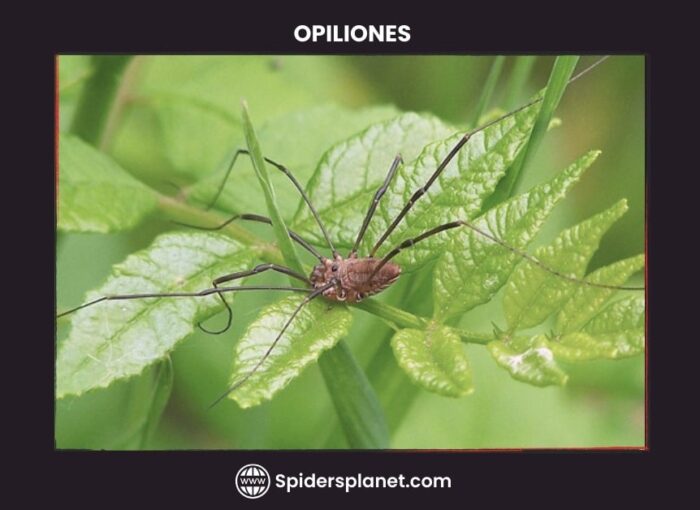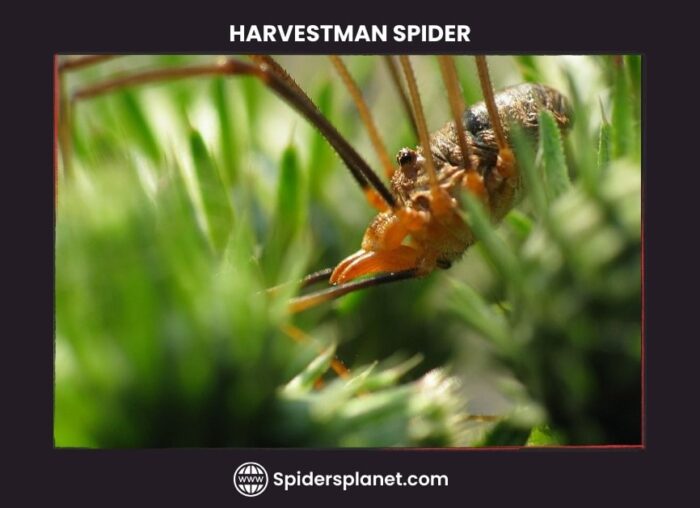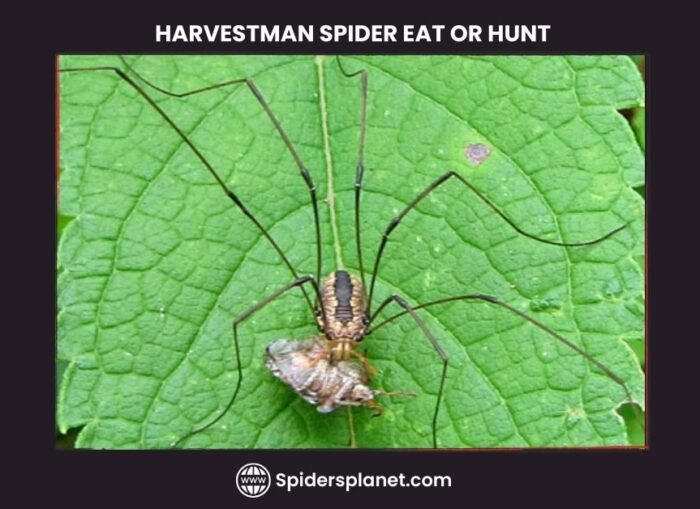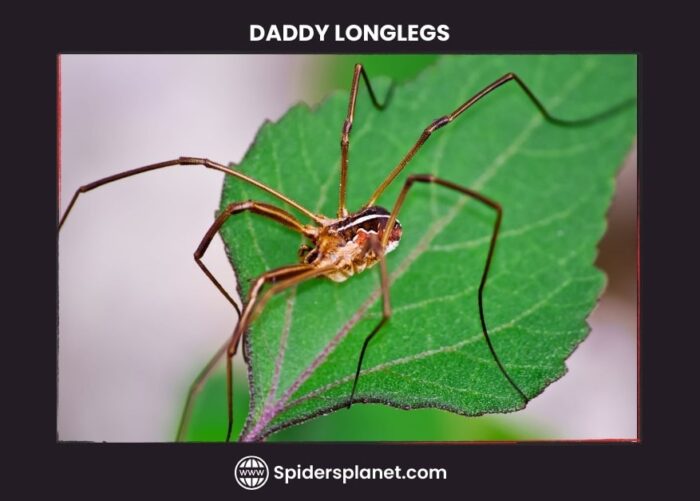Harvestmen spiders, commonly called “daddy longlegs,” part of the Opiliones order, are arachnids known for their unique long legs and compact bodies.
With over 6,000 species, they share some traits with spiders but are closer relatives to scorpions. Unlike true spiders, Daddy Longlegs’ bodies appear fused, creating the illusion of a single segment.
This distinctive feature distinguishes them from both spiders and scorpions.
Daddy longlegs come in two main types. The first type belongs to the Opiliones order (Harvestman). They do not have fangs or venom glands, and they eat a variety of foods like plants and small animals.
The second type is a daddy longlegs spider from the Pholcidae order (Cellar spiders), and it is venomous. But do not worry; their fangs are too tiny to be a threat to humans.
Keen to know more? In this article, we will learn all about the fascinating world of the Harvestman spider, exploring its appearance, habits, habitat, diet, lifecycle, and more.
Stay tuned for our next article, where we will provide detailed insights into Cellar spiders, too. Let’s explore the lives of these spiders and discover more about them together. Keep reading..!
Distinctive Features that set them apart from Spiders:
Harvestmen (Opiliones) are indeed arachnids, but their precise phylogenetic placement within the arachnid group has been debated.
Some studies suggest they are closely related to mites, while others propose a closer relationship to the Novogenuata, a group that includes scorpions, pseudoscorpions, and solifugae.

Harvestmen share similarities with spiders in terms of appearance, but they have distinct features that set them apart.
One notable difference is the fused body regions (cephalothorax and abdomen) in harvestmen, whereas spiders typically have a more clearly segmented body.
Additionally, harvestmen usually have a single pair of eyes located in the middle of the cephalothorax, distinguishing them from most spiders that often have multiple eyes.
Harvestmen lack venom glands, posing no threat to humans, and they do not produce silk for web construction.
The term “daddy longlegs” is indeed used colloquially for harvestmen in some English-speaking regions, but it is crucial to note that this name can confuse.
In various places, “daddy longlegs” may refer to different arthropods. For example, in some regions, it is used for crane flies (Tipulidae), while in others, it might be applied to cellar spiders (Pholcidae).
It demonstrates the importance of using scientific names to avoid ambiguity when referring to specific organisms.
Harvestman Spider Description:
Scientific Name and Family:
Scientifically known as Opiliones, these arachnids go by various common names such as Harvestmen, harvesters, harvest spiders, and daddy longlegs, classified within the domain Eukaryota.
It belongs to the animal kingdom (Animalia), the class is Arachnida (spiders, scorpions, mites), specifying its arachnid nature, and the order is Opiliones.
The name “harvestmen” is derived from the fact that most of them reach maturity in the autumn, coinciding with the time of harvesting.
Another interesting nickname for harvestmen is “shepherd spiders“, inspired by their long legs resembling the stilts some European shepherds use to watch their flocks from a distance.
Species:
With over 6,650 species discovered so far, the total number of Harvestman spider species is estimated to exceed 10,000.
Body and Harvestmen Ancient Discovery:
Harvestmen have a flat, oval-shaped body without a clear separation between the abdomen and cephalothorax (head). Their legs are notably long and slender, often surpassing their body size.
They possess a single pair of eyes situated on a small protruding plate and use chelicerae (fangs) for feeding. Unlike spiders, daddy longlegs lack silk glands, so they do not produce silk or build webs for trapping prey.

This unique combination of features distinguishes harvestmen from other arachnids.
As described in Wikipedia, well-preserved harvestmen fossils in ancient rocks, like the 400m year-old Rhynie cherts in Scotland and 305m year-old rocks in France, reveal a surprising fact.
The fossils, despite their age, exhibit a remarkably modern appearance, suggesting that the basic body shape of harvestmen developed long ago and has remained relatively unchanged over time.
Harvestman Spider Appearance:
Size:
Daddy longlegs have a rounded or egg-shaped body, varying in length from approximately 0.6 to 23 mm (0.02 to 0.9 inches).
The majority of species fall within the range of 3 to 7 mm (0.12 to 0.28 inches) in body size. Notably, their legs are disproportionately longer than their bodies, often several times in length.
The leg span can exceed 160 mm and reach up to 340 mm in some species. This unique body structure contributes to their distinctive appearance and is a characteristic feature of daddy longlegs.
Color:
Harvestmen, often associated with brown or gray tones, surprise observers with a diverse color spectrum.
While brown and gray offer effective camouflage, some species exhibit entirely black, vibrant yellow, orange, red, and even green hues.
Environmental factors, species genetics, mimicry strategies, and dimorphic distinctions influence their striking palette.
What They Like to Eat or Hunt?
Harvestmen are versatile eaters with omnivorous habits, consuming a variety of foods ranging from dead, squashed slugs and bird droppings to jam, fruit, and other plant remains.

They also prey on live small invertebrates that they manage to catch.
Habitat:
Harvestmen are distributed across South America and Southeast Asia, with diverse species found worldwide, frequently among leaf litter on the forest floor or clinging to tree bark. Primarily nocturnal, these arachnids exhibit activity during daylight hours as well.
In instances of dry conditions, they may congregate in sizable groups, seemingly to reduce water loss.
Notably, at least four daddy longleg species have been identified in Missouri caves, favoring dark and moist areas near cave entrances, showcasing their ability to thrive in various environments.
Behavior:
Harvestmen, despite their simple appearance, have interesting behaviors. Their long legs aid walking and quick movements. Some can detach their legs for defense.
They contribute to ecosystems by foraging on prey and organic matter. Socially, they are usually solitary but may gather in the fall.
Mating involves varied rituals, and they communicate using pheromones. Defense includes camouflage and chemical deterrents. They also groom, sunbathe, and molt. These behaviors showcase their adaptability in different habitats.
Lifecycle:
Male daddy longlegs possess a long, protrusible penis, and after mating in the autumn, the female uses her extended ovipositor to deposit eggs in a soil cleft.
These eggs hatch with the arrival of spring warmth. Despite their interesting way of reproducing, daddy longlegs have a short lifespan, usually less than a year.
Some males offer a special secretion before mating, and post copulation, they may guard females and defend territories.
Females lay eggs, and in some species, males provide parental care by guarding and cleaning the eggs. Depending on factors like temperature, eggs hatch within 20 days to six months.
Harvestmen typically go through six molts before reaching maturity.
Lifespan:
Typically lasting less than a year. However, exceptions exist, with some individuals surviving for several years.
Predators:
Harvestmen, despite their relatively gentle nature, face a diverse range of predators in the wild, including mammals, amphibians, insects, birds, and other arachnids.
To counter this variety of predators, harvestmen have evolved a diverse arsenal of defensive strategies:
Morphological Defenses:
- Body Armor: Sclerotized exoskeletons protect against bites and stings.
- Long Legs: Swift escapes are facilitated by their lengthy limbs.
- Autotomy: Some species can detach limbs, distracting and confusing predators.
Behavioral Defenses:
- Thanatosis (Playing Dead): Feigning death by remaining motionless and curling up legs.
- Camouflage: Blending coloration with surroundings for effective concealment.
- Bobbing: Rapid up and down rocking motion to disorient predators.
Chemical Defenses:
Certain species release noxious chemicals with unpleasant smells or tastes.
These arachnids, adept at navigating, hunting, and defending, demonstrate remarkable adaptability. Studying their behavior offers insights into their survival strategies and the intriguing dynamics of their ecosystems.

Harvestmen Spider Bite and Venom:
Harvestmen spiders, commonly known as daddy longlegs, may evoke fear due to their appearance, but there’s no need for concern. Harvestmen cannot bite humans.
Their small and weak chelicerae, devoid of venom glands and fangs, make them harmless to humans. While technically possessing venom glands, the venom is designed for subduing prey, posing no threat to humans.
In the rare instance of contact, any sensation would likely be minimal, akin to a tickle or prickling, with no harm caused.
Interesting Facts about Harvestman Spider:
- Daddy Longlegs, distinct from spiders, find their closest relatives among scorpions.
- These arachnids employ a unique defense mechanism known as “autotomy,” allowing them to detach legs when threatened, with the lost appendage regenerating over time.
- Harvestmen serve a vital ecological function as primary detritivores, playing a crucial role in ecosystems by feeding on decaying plant and animal matter.
- Additionally, some species display predatory behavior, preying on insects and other small invertebrates.
- Although these harvesters have venom, harvestmen’s venom is not potent enough to pose a threat to humans.
Harvestmen Spider vs Cellar Spider: A Comparative Look
| Feature | Harvestman (Opiliones) | Cellar Spider (Pholcidae) |
| Scientific Classification | Class Arachnida, Order Opiliones | Class Arachnida, Order Pholcidae |
| Body Shape | Flat, oval-shaped with no visible division between cephalothorax and abdomen | Elongated, cylindrical body with distinct cephalothorax and abdomen |
| Legs | Extremely long and slender legs, often exceeding body size | Long and thin legs, not as long as those of harvestmen |
| Eyes | One pair of eyes located on a small protruding plate | Six pairs of eyes arranged in three rows |
| Webs | Do not build webs | Spin irregular, messy webs |
| Venom | Yes, but weak and not harmful to humans | Yes, but weak and not harmful to humans |
| Diet | Primarily detritivores (feeding on dead and decaying matter) and predators (insects, other invertebrates) | Predators (insects, other invertebrates) |
| Habitat | Diverse, including forests, grasslands, homes, caves | Caves, cellars, other dark, damp places |
| Behavior | Solitary, nocturnal | Solitary, nocturnal |
| Movement | Walking, running, jumping | Walking, running, hanging |
| Defense | Autotomy (detaching legs), camouflage | Webs, hiding |
| Common Names | Daddy longlegs, harvestmen | Daddy longlegs, cellar spider, vibrating spider |
FAQs:
What do you call a female daddy longlegs?
Whether it is male or female, both are called daddy longlegs. This term encompasses various arachnid species like harvestmen, cellar spiders, and crane flies.
Are Daddy’s long legs poisonous?
No, Daddy Longlegs (harvestmen) are poisonous. Though they possess venom glands, their venom is too weak to harm humans.
What is the size record for a Harvestman spider?
The largest harvestman, discovered in a South American cave, belonged to the Opiliones family, boasting an impressive leg span of 13.4 inches. This sets the record for the largest daddy longlegs spider ever recorded.
Can we keep Harvestmen spiders as pets?
It is generally recommended to observe and appreciate harvestmen in their natural habitat rather than attempt to keep them as pets.
Harvestmen have short lifespans of 6-12 months in captivity, posing a challenge for pet owners. Their fragile, easily breakable legs make handling risky, and they demand specific environmental conditions for thriving, limiting suitability for inexperienced caretakers.
As solitary creatures, harvestmen have minimal interaction with humans, spending their time hiding or foraging.
Final Thoughts:
In our exploration of harvestmen spiders, or “daddy longlegs”, we have uncovered their unique traits and behaviors. With over 6,000 species, these arachnids, closer to scorpions than spiders, boast distinctive features like long legs and a fused body.
Beyond their common brown and gray hues, their vibrant color spectrum adds intrigue. Noteworthy for their role in nutrient cycling, they navigate diverse habitats from forests to caves.
Misconceptions or false beliefs are circulating about the potential danger of harvestmen’s venom, but in reality, it is not harmful or dangerous to humans.
The comparison with cellar spiders showcased intriguing differences. As we unravel more arachnid mysteries, stay tuned for insights into the world of cellar spiders in the next article!




Leave a Reply